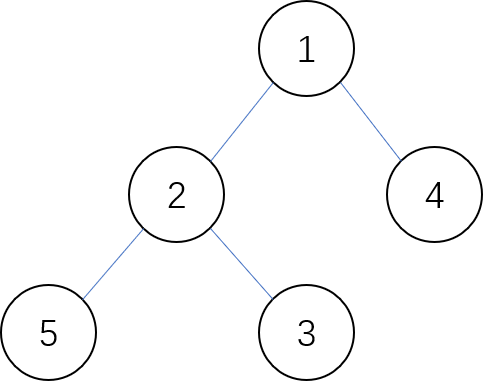非递归方式实现二叉树的后序遍历
Description
给定一个二叉树,用非递归的方式实现二叉树的后序遍历。
Input
输入第一行为一个整数 n(1 <= n <= 100000),表示二叉树的节点个数。
接下来共有 n 行,每行有两个整数 l 和 r,分别表示第 i (i为每一行的行号)个节点的左孩子和右孩子下标,值为 0 表示当前节点没有左孩子/右孩子。根节点的下标始终为 1。
Output
输出二叉树后续遍历的结果, 用空格分隔。
Sample Input
5 2 4 5 3 0 0 0 0 0 0
Sample Output
5 3 2 4 1
Hint
以第一组测试用例为例,二叉树共 5 个节点,接下来 5 行输入。
第 1 行为 2 4,表示节点编号为 1 的节点(根节点)的左孩子为编号为 2 的节点,右孩子为编号为 4 的节点。
第 2 行为 5 3,表示节点编号为 2 的节点的左孩子为编号为 5 的节点,右孩子为编号为 3 的节点。
后续输入均为 0,表示剩下编号为 3、4、5 的节点均无左/右孩子节点。

Answer
因为题目的输入是按编号顺序输入各个节点的数据,每个节点指出左右孩子。所以二叉树的建立可以采用顺序存储结构,通过节点类型的一维动态数组构建二叉树。因为第一行已经输入了节点数,数组容量已知,直接new一个出来就行。
#include <iostream> #include <vector> #include <stack> #include <algorithm> using namespace std; typedef struct BiTNode { int data; BiTNode *leftChild; BiTNode *rightChild; } BiTNode, *BiTree; vector<int> postorderTraversal(BiTree root) { vector<int> result; stack<BiTree> st; if (root == nullptr)return result; st.push(root); while (!st.empty()) { BiTree p = st.top(); st.pop(); result.push_back(p->data); if (p->leftChild != nullptr)st.push(p->leftChild); if (p->rightChild != nullptr)st.push(p->rightChild); } reverse(result.begin(), result.end());
//比较偷懒的办法,按照迭代前序遍历的程序,从中-左-右改成中-右-左,然后颠倒个个儿变成左-右-中。 return result; } void Display(const vector<int> &res, int n) { for (int i = 0; i < n; i++) { cout << res[i] << ' '; } } BiTree CreateTree(int n) { int l, r; BiTNode *T = new BiTNode[n]; for (int i = 0; i < n; i++) { T[i].data = i + 1; cin >> l; cin >> r; if (l == 0)T[i].leftChild = nullptr; else T[i].leftChild = &T[l - 1]; if (r == 0)T[i].rightChild = nullptr; else T[i].rightChild = &T[r - 1]; } return T; } int main() { int n; cin >> n; BiTree T = CreateTree(n); vector<int> res = postorderTraversal(T); Display(res, n); }
Tip:
作为新手,写代码不熟练,一开始没有 BiTNode *T = new BiTNode[n]; 而是直接 BiTNode T[n]; 只是定义而并没有为数组分配空间,后面的取地址自然错了,都没有空间,何来的地址?
同样,使用vector时,如果给了大小,就一开始直接 vector<BiNode> T(n); 就相当于new了一个n大小的容器出来,这样才分配了地址空间,否则不加(n)等于vector容量为0。


 浙公网安备 33010602011771号
浙公网安备 33010602011771号